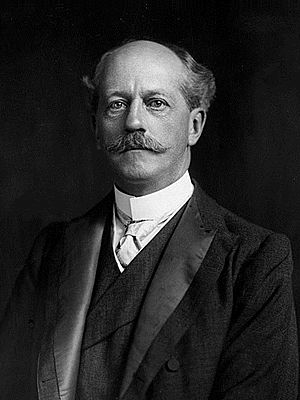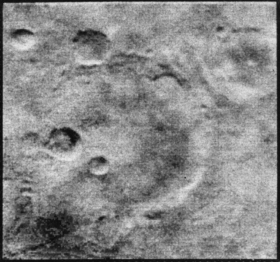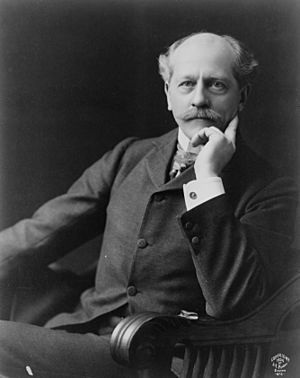Percival Lowell facts for kids
Quick facts for kids
Percival Lowell
|
|
|---|---|

Percival Lowell during the early-20th century
|
|
| Born | March 13, 1855 Boston, Massachusetts, U.S.
|
| Died | November 12, 1916 (aged 61) Flagstaff, Arizona, U.S.
|
| Resting place | Mars Hill, Lowell Observatory |
| Nationality | American |
| Education | Noble and Greenough School |
| Alma mater | Harvard University |
| Known for | Martian canals, Asteroids discovered: 793 Arizona (April 9, 1907) |
| Scientific career | |
| Fields | Astronomy |
| Signature | |
Percival Lowell (born March 13, 1855 – died November 12, 1916) was an American businessman, writer, and astronomer. He became famous for suggesting that there were "canals" on Mars. He also helped develop ideas about a ninth planet in our Solar System.
Lowell founded the Lowell Observatory in Flagstaff, Arizona. His work helped lead to the discovery of Pluto 14 years after he passed away.
Contents
Life and Work
Early Years and Travels
Percival Lowell was born in Boston, Massachusetts, on March 13, 1855. He was the first son of Augustus and Katherine Lowell. His family was well-known in Boston.
He graduated from Harvard University in 1876. He studied mathematics and gave a speech about how the Solar System formed. After college, he managed a cotton mill for six years.
In the 1880s, Lowell traveled a lot in East Asia. He visited Korea and Japan. He wrote books about Japanese culture, religion, and daily life. These books shared his observations and thoughts about the region.
After returning to the United States in 1893, Lowell decided to focus on astronomy. He was very interested in Mars after reading a book by Camille Flammarion. He was especially curious about the "canals" that Italian astronomer Giovanni Schiaparelli had drawn on Mars.
Founding Lowell Observatory
Lowell used his money and influence to start his own observatory. He chose Flagstaff, Arizona as the location. This spot was over 2,100 meters (7,000 feet) high. It had clear skies and was far from city lights. This made it a perfect place for observing stars and planets.
Lowell was one of the first to build an observatory in a remote, high place for the best views. He believed smaller telescopes were better for seeing fine details on planets. For the last 23 years of his life, astronomy and his observatory were his main focus.
Percival Lowell passed away on November 12, 1916, at age 61. He is buried near his observatory in Flagstaff.
Studying Mars
The Martian Canals Idea
For about 15 years, from 1893 to 1908, Lowell carefully studied Mars. He made many detailed drawings of what he saw on its surface. He wrote three books about his ideas: Mars (1895), Mars and Its Canals (1906), and Mars As the Abode of Life (1908).
Through his writings, Lowell helped make the idea of "canals" on Mars very popular. He thought these markings showed that intelligent beings lived on Mars. He believed these beings had built the canals to carry water from the planet's ice caps. He imagined a dying planet where an advanced civilization was trying to survive.

However, many other astronomers were doubtful. They couldn't see the markings as clearly as Lowell did. They also didn't believe the markings were as widespread as he claimed. In 1909, a larger telescope at Mount Wilson Observatory showed that the "canals" were actually natural, uneven geological features.
The idea of canals on Mars was finally disproven in the 1960s. NASA's Mariner spacecraft flew past Mars and took pictures. These pictures showed a surface covered in craters, not canals. Today, scientists know that the "canals" were an optical illusion. This means Lowell and others might have seen patterns that weren't really there, possibly due to how their eyes and brains interpreted faint lines.
Other Discoveries
Venus Spokes
Lowell also observed the planet Venus. He started studying Venus in 1896. He drew maps of Venus showing spoke-like features and a dark spot in the center.
However, we now know that Venus is covered by thick clouds. Its surface cannot be seen from Earth. Scientists later suggested that Lowell might have been seeing shadows of blood vessels in his own eye. This can happen when looking through a telescope in a certain way.
The Search for Pluto
Lowell's most important work in planetary studies came in his last ten years. He spent this time searching for "Planet X". This was a hypothetical planet he believed existed beyond Neptune. Lowell thought that the gravity of this unseen planet was pulling on Uranus and Neptune, changing their orbits.
He started a search program in 1906. His team, including a woman named Elizabeth Williams, calculated where this planet might be. Lowell Observatory even took pictures of Pluto in 1915. But at the time, they didn't realize it was a planet and thought it was just a star.
In 1930, Clyde Tombaugh, working at the Lowell Observatory, finally discovered Pluto. It was found near the area Lowell had predicted. To honor Lowell's efforts, the symbol for Pluto (♇) uses the first two letters of Pluto's name, which are also Lowell's initials.
However, it was later found that the "Planet X" theory was incorrect. Scientists learned that Pluto is too small to affect Uranus and Neptune's orbits. Also, the small differences in Uranus and Neptune's predicted positions were due to a slightly wrong measurement of Neptune's mass. Once Voyager 2 measured Neptune's mass more accurately in 1989, those differences disappeared.
Legacy
Even though Lowell's ideas about Martian canals, Venus's surface, and Planet X were later proven wrong, he had a lasting impact. He showed the importance of building observatories in the best possible locations. He also created the program and setting that led to the discovery of Pluto.
Many scientists see Lowell as a very important person who made planetary science popular in America. His vision of Mars, with its ancient civilization and canals, greatly influenced science fiction. Books like H. G. Wells' The War of the Worlds and Ray Bradbury's The Martian Chronicles were inspired by his ideas. Even today, his vision of Mars appears in many classic science fiction stories.
Several places in space are named after him:
- Asteroid 1886 Lowell
- Crater Lowell on the Moon
- Crater Lowell on Mars
- The Lowell Regio on Pluto, discovered by the New Horizons spacecraft in 2015.
See also
 In Spanish: Percival Lowell para niños
In Spanish: Percival Lowell para niños
- Life on Mars
- Noto Peninsula
- Wrexie Leonard






